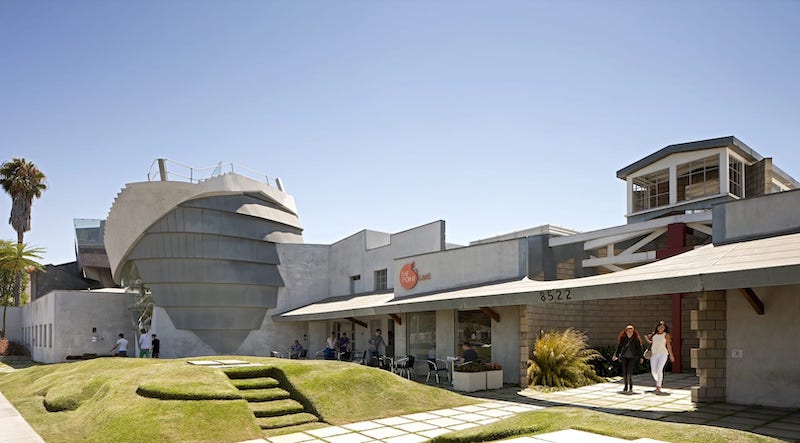The American Institute of Architects (AIA) is honoring Conjunctive Points – The New City, designed by Eric Owen Moss Architects, with its Twenty-five Year Award.
AIA’s Twenty-five Year Award is conferred on a building that has set a precedent for the last 25-35 years and continues to set standards of excellence for its architectural design and significance.
Initiated in 1986 within the Hayden Tract, a former industrial site bounding Central Los Angeles and Culver City, Conjunctive Points – The New City began as simple additions and subtractions to an existing collection of warehouses. With architect Eric Owen Moss designing or renovating one eclectic building at a time, the project set contemporary standards for adaptive re-use, launched the concept of creative office space, and positioned architecture as a method to uncover new social and civic opportunities.
The land developers Frederick and Laurie Samitaur Smith had acquired a significant collection of buildings along the tract, many of which were vacant wood-framed, long-span warehouses and manufacturing spaces. The resulting exchange of ideas across three decades has reversed the area’s plummeting property values and rising crime rates and become a subject of study for the planners, architects, and policy makers who are rethinking cities.
8522 National Boulevard, the first project Moss designed in the Hayden Tract, set the architectural and organizational precedent for what is now known as Conjunctive Points – The New City. At first, Moss’ careful remodels and idiosyncratic buildings with playful, singular names—Umbrella, Beehive, Pterodactyl—attracted small start-ups and young entrepreneurs providing music, graphics, advertising, and post-production services. Since then, major companies such as Nike, Converse, and, most recently, Beats, GoPro, and Apple, have followed in the neighborhood. In an area once devoid of purpose, Conjunctive Points – The New City has prompted significant job creation with an estimated 15,000 newly employed workers flocking there. It remains one of the Los Angeles area’s most desired office locations.
Visit AIA’s website to learn more about the Twenty-five Year Award.
Related Stories
MFPRO+ News | Jun 24, 2024
‘Yes in God’s Backyard’ movement could create more affordable housing
The so-called “Yes in God’s Backyard” (YIGBY) movement, where houses of worship convert their properties to housing, could help alleviate the serious housing crisis affecting many communities around the country.
Student Housing | Jun 20, 2024
How student housing developments are evolving to meet new expectations
The days of uninspired dorm rooms with little more than a bed and a communal bathroom down the hall are long gone. Students increasingly seek inclusive design, communities to enhance learning and living, and a focus on wellness that encompasses everything from meditation spaces to mental health resources.
Museums | Jun 20, 2024
Connecticut’s Bruce Museum more than doubles its size with a 42,000-sf, three-floor addition
In Greenwich, Conn., the Bruce Museum, a multidisciplinary institution highlighting art, science, and history, has undergone a campus revitalization and expansion that more than doubles the museum’s size. Designed by EskewDumezRipple and built by Turner Construction, the project includes a 42,000-sf, three-floor addition as well as a comprehensive renovation of the 32,500-sf museum, which was originally built as a private home in the mid-19th century and expanded in the early 1990s.
Building Technology | Jun 18, 2024
Could ‘smart’ building facades heat and cool buildings?
A promising research project looks at the possibilities for thermoelectric systems to thermally condition buildings, writes Mahsa Farid Mohajer, Sustainable Building Analyst with Stantec.
University Buildings | Jun 18, 2024
UC Riverside’s new School of Medicine building supports team-based learning, showcases passive design strategies
The University of California, Riverside, School of Medicine has opened the 94,576-sf, five-floor Education Building II (EDII). Created by the design-build team of CO Architects and Hensel Phelps, the medical school’s new home supports team-based student learning, offers social spaces, and provides departmental offices for faculty and staff.
Healthcare Facilities | Jun 18, 2024
A healthcare simulation technology consultant can save time, money, and headaches
As the demand for skilled healthcare professionals continues to rise, healthcare simulation is playing an increasingly vital role in the skill development, compliance, and continuing education of the clinical workforce.
Mass Timber | Jun 17, 2024
British Columbia hospital features mass timber community hall
The Cowichan District Hospital Replacement Project in Duncan, British Columbia, features an expansive community hall featuring mass timber construction. The hall, designed to promote social interaction and connection to give patients, families, and staff a warm and welcoming environment, connects a Diagnostic and Treatment (“D&T”) Block and Inpatient Tower.
Concrete Technology | Jun 17, 2024
MIT researchers are working on a way to use concrete as an electric battery
Researchers at MIT have developed a concrete mixture that can store electrical energy. The researchers say the mixture of water, cement, and carbon black could be used for building foundations and street paving.
Codes and Standards | Jun 17, 2024
Federal government releases national definition of a zero emissions building
The U.S. Department of Energy has released a new national definition of a zero emissions building. The definition is intended to provide industry guidance to support new and existing commercial and residential buildings to move towards zero emissions across the entire building sector, DOE says.
Multifamily Housing | Jun 14, 2024
AEC inspections are the key to financially viable office to residential adaptive reuse projects
About a year ago our industry was abuzz with an idea that seemed like a one-shot miracle cure for both the shockingly high rate of office vacancies and the worsening housing shortage. The seemingly simple idea of converting empty office buildings to multifamily residential seemed like an easy and elegant solution. However, in the intervening months we’ve seen only a handful of these conversions, despite near universal enthusiasm for the concept.

















